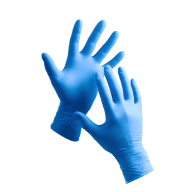Uvex HexArmor HexChem 7061 Safety Gloves
Uvex
visit storeProduct description
The Uvex HexChem protective gloves combine superior chemical resistance with industry-leading cut protection, featuring a full nitrile coating for comprehensive fluid barrier protection. The innovative design incorporates a 360° cut-resistant interior liner while maintaining high dexterity and form-fitting comfort. The extended 14-inch gauntlet provides additional arm coverage, making these gloves ideal for demanding chemical handling applications.
Product Features:
- Full nitrile coating for superior chemical and fluid resistance
- 360° cut-resistant interior liner
- Superior wet/dry grip and abrasion resistance
- High dexterity and form-fitting design
- Extended 14" gauntlet for enhanced protection
Technical Details:
- ANSI/ISEA Cut Grade A4 (1556 gram score)
- ANSI/ISEA Puncture Level 2
- ANSI/ISEA Abrasion Level 5
- Style: Liquid/Chemical
- Grip: Wet or dry
Standards:
- EN388:2016 4X41D
- EN ISO 374-1/Type A JKLMOT
- EN ISO 374-5
- EN407:2004 X1XXXX
Recommended Applications:
- Chemical handling
- Fluid management
- Industrial applications requiring chemical resistance
The material applied to glove surfaces to enhance grip, protection, and durability for specific work conditions and hazards.
Multi-purpose design offers versatile protection and comfort, ready for a wide range of tasks.
Full finger coverage offers complete protection and warmth, keeping your hands safe and comfortable.
Determines how the glove secures around the wrist, affecting fit, protection from debris, and ease of putting gloves on and taking them off.
Indicates which areas of the glove have protective or grip-enhancing coating applied, affecting durability, grip, and dexterity in different work tasks.
Measures how far up the arm the glove extends, determining the area of protection from fingertip to cuff end for different safety requirements.
- Chemical Resistance
- Cut Resistant
- Slip Resistant
- Antimicrobial Protection
- Hand Protection
Request a free sample
Test first and buy later. Visit any product page to request your free sample.
Standards and labels
EN 388:2016 is a European standard for measuring the performance of protective gloves against mechanical risks (abrasion, cut, tear, and puncture). The standard includes test methods and performance requirements for gloves to be considered compliant. Test results are reported using a series of four numbers, each representing the performance level achieved in one of the tests.
Test results
Tear Resistance Level 4EN 388:2016 is a European standard that establishes criteria for assessing the protection provided by gloves against mechanical hazards, including tear resistance. The Tear Resistance Level 4 classification represents the highest level of tear resistance defined by this standard, indicating that the gloves can withstand the most substantial forces before tearing. According to the testing methodology, gloves are evaluated by measuring the force required to tear a sample of the glove material, with Level 4 requiring a force of over 75 Newtons to initiate and propagate a tear. This high level of tear resistance is ideal for use in environments where gloves are subjected to significant stress and potential damage, such as in heavy industry, construction, and handling of materials with sharp edges. Gloves achieving this level offer superior durability and are essential for ensuring user safety in high-risk mechanical settings, thereby enhancing work efficiency and reducing the frequency of glove replacement.
Puncture Resistance Level 1The European standard EN 388:2016 addresses the puncture resistance of protective gloves, with puncture resistance classified from Levels 1 to 4. Specifically, a Level 1 result indicates minimal puncture resistance. This level of resistance is determined by a test involving a standardized stylus with a specified diameter and force. During the test, the stylus is pressed against the material with a force up to 20 Newtons to assess how well the glove can withstand penetration. A Level 1 rating signifies that the glove provides basic protection against small punctures or stabs, appropriate for areas with minimal risk. Practical implications for this test result suggest the gloves are suitable for light tasks where major risks of punctures are not anticipated, but are not adequate for handling sharp tools or heavy equipment where higher penetration resistance would be necessary.
Cut Resistance, ISO 13997 Level DCut Resistance according to the ISO 13997 result under the European Standard EN 388:2016 quantifies the level of resistance a material offers against cutting where the required force to cut through the protective material is between 15 and 21 Newtons. This test method involves applying a straight-edge blade under load over the material's surface and determining the load at which the blade cuts through at a standard length of cut. This stringent testing is critical for products like protective gloves or garments, where high cut resistance ensures better safety and durability in environments where sharp objects are handled. Understanding and adhering to this standard helps procure suitable protective gear that meets safety requirements and offers expected protection for specific risk exposures .
Abrasion Resistance Level 4EN 388:2016 uses a specific test method to measure abrasion resistance of safety gloves; the gloves’ material is subjected to sandpaper under pressure to observe the number of cycles needed to wear through the material. Level 4 in this standard indicates that the material withstood 8,000 cycles before a hole was made. Practically, this means that gloves rated at Level 4 for abrasion resistance offer very high resilience against wearing through, making them suitable for tasks involving significant contact with rough surfaces .
Cut Resistance, ISO 13997 Level XThe standard EN 388:2016, specifically its segment referring to ISO 13997 test, is designed to assess the cut resistance of materials used in protective gloves. A result denoted as 'Level X' means that test is not performed and the cut resistance of the product cannot be guaranteed.
EN 407:2004 is a European standard that specifies the safety requirements for protective gloves for thermal risks. It sets rules for the design, construction, and testing of gloves that protect users from heat and fire. Testing includes measurements of contact heat, convective heat, radiant heat, small splashes of molten metal and flame resistance. The standard also includes requirements for labeling and instructions for use. This standard is an updated version of EN 407:1994 and it's intended to protect the users against thermal risks, such as heat and flame, and to help them to choose a suitable glove for their specific application.
Test results
Burning Behaviour Level XThe EN 407:2004 standard addresses the burning behavior of gloves protecting from heat and/or fire. A performance level X in this context indicates that the glove has not been submitted for testing under the specified part of the standard or failed the test.
Metal Splash Resistance Level XThe EN 407:2004 standard specifies different levels of protection for gloves against thermal risks, including metal splash resistance. A result marked as 'Level X' under this standard symbolizes that the glove material either did not meet the minimum requirements for testing or that no specific test was conducted for this hazard. The test for Metal Splash Resistance in EN 407:2004 involves exposing the glove material to molten metal splashes to determine how much molten metal is required to heat the glove material to a degree that it would cause pain or injury to the wearer. The practical implication of a 'Level X' rating is that gloves marked as such should not be relied upon for protection against risks of molten metal splashes, making them unsuitable for use in environments where exposure to this hazard is likely.
Molten Metal Resistance Level XEN 407:2004 is a European standard that provides specifications for protective gloves to safeguard against thermal risks, including the exposure to molten metals. The designation Molten Metal Resistance Level X indicates that the gloves have not been tested for this specific risk, or they failed to meet the minimum requirements set out in the standard for protection against molten metal splashes. This means that the gloves are either unsuitable for use in environments where there is a risk of contact with molten metals, or additional testing is required to determine their suitability. Typically, such a classification implies that the gloves should not be used for handling molten metals and should only be considered for other types of thermal risks specified in the standard, where molten metal exposure is not a concern. This classification helps in ensuring that users select the right type of glove based on the specific hazards present in their working environment, thereby preventing inappropriate use and enhancing safety.
Heat Contact Level 1The standard EN 407:2004 on Protective gloves against thermal risks, including the testing for contact heat at Level 1, is designed to assess the protection level of gloves when exposed to thermal hazards. A Level 1 result on the contact heat resistance indicates basic protection where the glove can delay the transfer of heat from a contact source at 100°C for at least 15 seconds before the inside of the glove reaches a temperature increase of 10°C. The test method involves placing the outer surface of the glove in contact with a hot probe of defined dimensions and temperature, while the rate of temperature rise of a calorimeter on the inside of the glove is measured. This measurement provides a straightforward metric for assessing the thermal protection offered by the glove at low-level exposure. Practically, gloves rated at Level 1 for contact heat are suitable for environments where exposure to thermal risks is minimal and not excessively severe, making them adequate for certain low-risk industrial, laboratory, or handling applications where brief contact with warm objects is common.
Heat Convection Level XThe EN 407:2004 European standard and its annexure for Heat Convection Level X is designed to gauge the protective capability of gloves when exposed to heat transmitted through a fluid medium, such as air or steam. The designation of Level X specifically indicates that the material did not meet the minimum requirements set forth in the test, or wasn't tested due to being deemed unsuitable for this type of exposure based on the nature of the material. The test method for determining this involves measuring the time it takes for the material to increase in temperature by 24°C under standardized conditions of convection heat exposure. This test is important for defining the efficacy of protective gear under various industrial conditions where heat convection is a risk.
Radiant Heat Level XEN 407:2004 is a European standard that sets the requirements for protective gloves to defend against various thermal hazards, including radiant heat. The designation Radiant Heat Level X indicates that the gloves have not been tested for this specific type of protection, or they did not meet the minimum criteria established by the standard for resisting radiant heat. This means that these gloves are not certified for protection against radiant heat, which involves the transmission of heat through infrared rays from a heat source without direct contact. The lack of a specific radiant heat protection level suggests that users should not rely on these gloves for tasks where significant exposure to radiant heat is expected. Instead, these gloves might be suitable for other types of thermal risks for which they are certified, ensuring users select the appropriate type of protective glove based on the specific hazards present in their working environment. This classification assists in preventing inappropriate glove use and enhancing worker safety by clearly indicating the limitations of the glove's protective capabilities.
EN ISO 374-1:2016 is a standard that defines the performance requirements for gloves that protect against chemicals and microorganisms. The standard specifies the design, materials, and testing requirements for gloves to protect against chemicals and microorganisms. Possible test results include measurements of the gloves' permeation resistance, degradation, and penetration. It also includes the safety and functionality requirements for gloves.
Test results
Specified Requirements Type AEN 374-5:2016 is a European standard for gloves that protect against microorganisms, specifically gloves that are used for medical and dental procedures. It sets rules for how the gloves should protect against microorganisms and how to test if they meet the standards. Gloves that pass the tests can have a label that says they meet the standard. The test results can be pass or fail for each test that checks the gloves resistance to microorganisms.
Test results
Micro-organisms VirusEN 374-5:2016 is a standard that outlines the requirements and testing methods for protective gloves designed to protect against viruses. The designation 'Virus' indicates that the gloves have passed specific tests confirming their barrier effectiveness against viruses. These tests involve assessing the glove material's resistance to penetration by blood-borne pathogens and other virus-containing fluids, using a bacteriophage as a surrogate virus due to its small size and resistance. Gloves that meet this standard are vital in healthcare settings, laboratories, and any environment where there is a risk of exposure to viral infections. They are crucial for preventing the transmission of diseases, ensuring that workers are protected when handling potentially infectious materials, thus enhancing safety and health protocols in workplaces with biological hazards.
Micro-organisms Bacteria & FungiEN 374-5:2016 specifies the requirements and test methods for protective gloves intended to protect against bacteria and fungi. The designation 'Bacteria & Fungi' indicates that the gloves have been tested and verified to provide effective barrier protection against microbial agents. The testing involves evaluating the glove's material and seams for their impermeability to microorganisms under conditions that simulate real-world use, ensuring no penetration occurs through the glove material or at the seams. Gloves certified under this standard are crucial for use in environments such as healthcare, laboratory settings, and any applications where preventing the transmission of infectious agents is essential. They help ensure the safety and hygiene of workers by providing reliable protection against the risks of bacterial and fungal contamination.
CE Marking is a label that shows a product meets certain safety and environmental standards set by the European Union. To get the CE Marking, a company must test and certify their product meets these standards. CE Marking is required for many products sold in the EU, including electronics, machinery, toys and medical devices. It helps ensure that products are safe for consumers and the environment, and allows for easy trade within the EU.
Uvex delivery terms
Free delivery when you order more than 1 650,00 kr from Uvex
Supplier shipping fee 60,00 kr
Brand minimum 0,00 kr
Price available on request
Shipping fee is 60,00 kr for orders under 1 650,00 kr
Sold in units of one pair
Need larger quantities?
Other products you may like
Recently viewed
Need help?
Get help from our experts
Other products you may like
Similar products you may like
Autonomous sourcing platform
The most efficient way to source and order supplies for your operations
Sourcing
Ordering
List products you’re looking for and we’ll find the best products and prices for you – all for free.
Need help?
Get help from our experts




